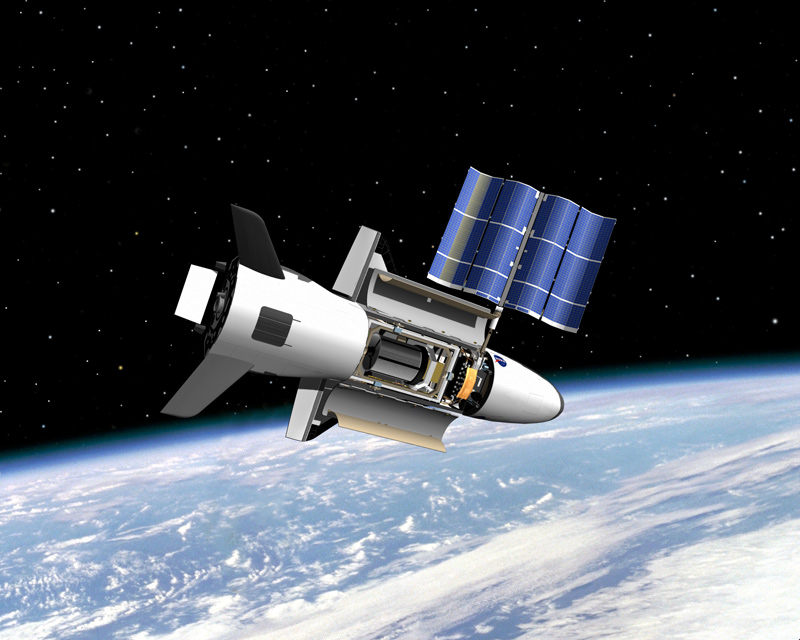Air Force's Secretive X-37B Space Plane May Land Friday

The U.S. Air Force is standing ready for this week's much anticipated return to Earth of a robotic space plane that has spent more than a year in orbit on a secret mission.
Air Force officials say landing day for the unmanned X-37B space plane is imminent, and could occur on Friday (June 15). But weather conditions at its intended landing site at Vandenberg Air Force Base in California, as well as other factors, will determine when the spacecraft's will ultimately land.
"Team Vandenberg is prepared to safely receive the X-37B at a moment's notice," Air Force Lt. Austin Fallin told SPACE.com in an email this week. "Exact landing date and time depend on weather and technical considerations."
The X-37B spacecraft's landing window opened on June 11 and runs through June 18, with Friday being the next opportunity, Fallin said. The exact nature of the space plane's mission is classified, so aside from a brief May 30 statement announcing the upcoming landing in the mid-June timeframe, Air Force officials have remained mum on re-entry details. [Photos: Air Force's 2nd Secret X-37B Mission]
"More information will be released as it becomes available," Fallin said.
The X-37B space plane set to land this week is known as the Orbital Test Vehicle 2 (OTV-2) and looks much like a smaller version of NASA's reusable space shuttles. Unlike NASA's shuttles, the OTV-2 is completely unmanned and is powered by a solar panel that allows it to stay in orbit for months at a time.
Air Force officials have said the estimated mission length for its X-37B space planes (there are currently two) is about 270 days, but the OTV-2 mission has far outlasted that timeframe. The OTV-2 mission launched into orbit on March 5, 2011 and has racked up more than 460 days in orbit so far.
Get the Space.com Newsletter
Breaking space news, the latest updates on rocket launches, skywatching events and more!
The Air Force's X-37B space planes are built by Boeing and originally began as a NASA test program that shifted into the U.S military's control in 2006, first to DARPA and then to the Air Force, due to funding issues. Each X-37B spacecraft is about 29 feet long (8.8 meters) 15 feet wide (4.5 m), and has a payload bay about the size of a pickup truck bed.
The spacecraft are launched into orbit atop unmanned Atlas 5 rockets and are designed to guide themselves back to Earth on autopilot by re-entering the atmosphere and landing on a runway at Vandenberg. The OTV-2 mission and its predecessor were launched from Cape Canaveral Air Force Station in Florida.
The first X-37B space plane, OTV-1, launched in 2010 and spent 225 days in space. This OTV-2 mission has more than doubled the duration of that debut flight. Air Force officials have said they intend to launch the OTV-1 vehicle on another test flight soon, possibly as soon as this fall.
You can follow SPACE.com Managing Editor Tariq Malik on Twitter @tariqjmalik. Follow SPACE.com on Twitter @Spacedotcom. We're also on Facebookand Google+.
Join our Space Forums to keep talking space on the latest missions, night sky and more! And if you have a news tip, correction or comment, let us know at: community@space.com.

Tariq is the Editor-in-Chief of Space.com and joined the team in 2001, first as an intern and staff writer, and later as an editor. He covers human spaceflight, exploration and space science, as well as skywatching and entertainment. He became Space.com's Managing Editor in 2009 and Editor-in-Chief in 2019. Before joining Space.com, Tariq was a staff reporter for The Los Angeles Times covering education and city beats in La Habra, Fullerton and Huntington Beach. In October 2022, Tariq received the Harry Kolcum Award for excellence in space reporting from the National Space Club Florida Committee. He is also an Eagle Scout (yes, he has the Space Exploration merit badge) and went to Space Camp four times as a kid and a fifth time as an adult. He has journalism degrees from the University of Southern California and New York University. You can find Tariq at Space.com and as the co-host to the This Week In Space podcast with space historian Rod Pyle on the TWiT network. To see his latest project, you can follow Tariq on Twitter @tariqjmalik.
